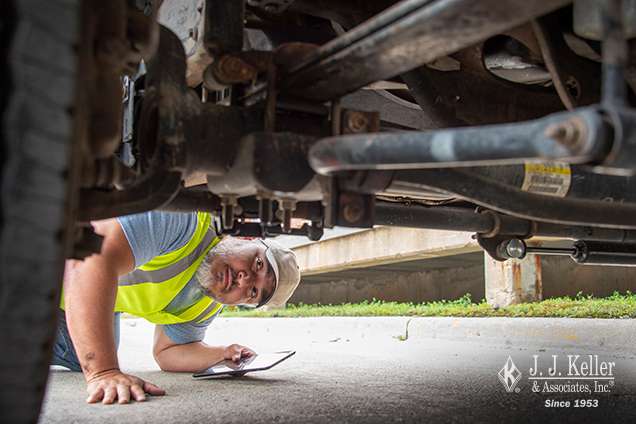Sr. Industry Business Advisor, J. J. Keller & Associates, Inc.
Do You Know the Power of a Vehicle Inspection?

While the regulations require motor carriers to have a “systematic” inspection and maintenance program, they leave it up to carriers to decide what the program looks like. However, best-in-class fleets leverage the humble daily vehicle inspection process to achieve compliance, safety, and operational goals. And in return, they receive the tangible benefits of greater productivity, lower repair costs, and better driver retention.
PRE- AND POST-TRIP INSPECTIONS
Daily vehicle inspections aren’t rocket science. The federal rules require drivers to be satisfied that the vehicle is safe before driving, which means a pre-trip inspection is needed per §392.7-§392.9. No documentation is required unless companies require that in their policies.
At the post-trip stage, an inspection is required per §396.11. However, truck and passenger-carrying vehicle drivers must complete a DVIR only when there's a defect to report unless company policy requires a DVIR regardless of defects.
A DVIR with a defect noted should have three signatures:
- The driver that discovered and reported the defect on the DVIR,
- The mechanic or company official certifying that the repair was completed, and
- The next driver to pre-trip the vehicle.
RETENTION
DVIRs must be retained for at least three months.
Consider using electronic DVIRs (EDVIRs) to make vehicle data easily accessible, and allow for quicker sorting, analysis, and sharing. They assist you in proactively monitoring maintenance to achieve reduced downtime and unplanned expenses.
EDVIRs can also be used to verify and document that driver inspections occur in compliance with your company policies and procedures, helping you maintain an effective maintenance program.
VEHICLE INSPECTION TIPS
- Train and retrain drivers on conducting the required inspections. Include inspection reminders and updates in routine communications.
- Compare drivers' DVIRs and maintenance requests to what your technicians discover during maintenance work. For example, the technician finds a defect the driver should have seen, but it was not reported on a DVIR or maintenance request. Counsel the driver accordingly.
- Observe drivers' pre-trips and post-trips at the company facilities. If you see a driver conduct an inadequate inspection, counsel them right away.
- Observe drivers at locations where an inspection would be required under your policies (for example, at a customer's facility or fuel stop). If a driver is seen not conducting a required inspection, counsel them right away.
- Scan your incoming roadside inspection reports for mechanical violations that drivers should have caught during a pre-trip inspection. Counsel drivers accordingly. Proactive fleets often reward and recognize drivers for violation-free roadside inspections.
Your maintenance program will fail if drivers do not do the required inspections. Instead of smooth operations, you'll have a fleet of unreliable and dangerous vehicles, FMCSA violations and fines, and out-of-service orders. Or worse, litigation resulting from a crash in which a vehicle could not respond effectively in an emergency.
2021 TOP 10 VEHICLE VIOLATIONS
Average carriers will likely see the violations listed below. However, if you develop your safety and compliance program in consideration of the top vehicle violations below, you may be able to avoid the top violations many carriers receive:
- Inoperable required lamp
- Operating a CMV without proof of a periodic inspection
- Brake out-of-adjustment
- No/discharged/unsecured fire extinguisher
- Inoperative turn signal
- Inspection, repair and maintenance of parts and accessories
- Tire-flat and/or audible air leak
- Automatic air brake adjustment system fails to compensate for wear
- No or defective lighting devices or reflective material as required
- Windshield wipers inoperative/defective
BEST PRACTICE
Vehicle violations are usually the hardest to keep to a minimum. It's a good idea to review your company’s Compliance, Safety, Accountability (CSA) data at least every month. Roadside inspection and investigation data are used to score your company and drivers in the seven compliance categories of the CSA enforcement program. Therefore, it's in your best interest to look for "bad" data impacting your scores, such as a violation that isn't accurate or an inspection that doesn't belong to your operation. Challenge incorrect data with the online DataQs system to get it off your record. This is especially important for small fleets as each inspection will weigh more heavily on their scores.
THE BOTTOM LINE
- Have a systematic, preventive, and effective maintenance program.
- Make sure your driver knows how to do the required inspections and that they are actually doing them.
- Ensure mechanics seek out and remedy minor problems before they balloon into major ones, rather than just reacting to the latest issue that surfaces.
- Ensure mechanics focus on rigorous inspections and replace components before a failure or being below specification.
- Review inspections, document all efforts, and retain compliant records, discarding them when the retention period expires.
About J. J. Keller & Associates, Inc.
Since we began as a family-owned company in 1953, our purpose at J. J. Keller & Associates, Inc. has been to protect people and the businesses they run. Today, serving 500,000+ companies across North America, our associates are proud to make a larger impact than ever. Transportation, construction and industrial organizations of all sizes rely on our expert insights to create safe work environments and simplify complex government regulations. They trust our diversified portfolio of solutions – cloud-based management tools, consulting, professional services, training, forms, PPE and safety supplies – to safeguard workers, reduce risk and build operational confidence. www.jjkeller.com
The above article is sponsor-generated content. To learn more about sponsor-generated content, click here.


